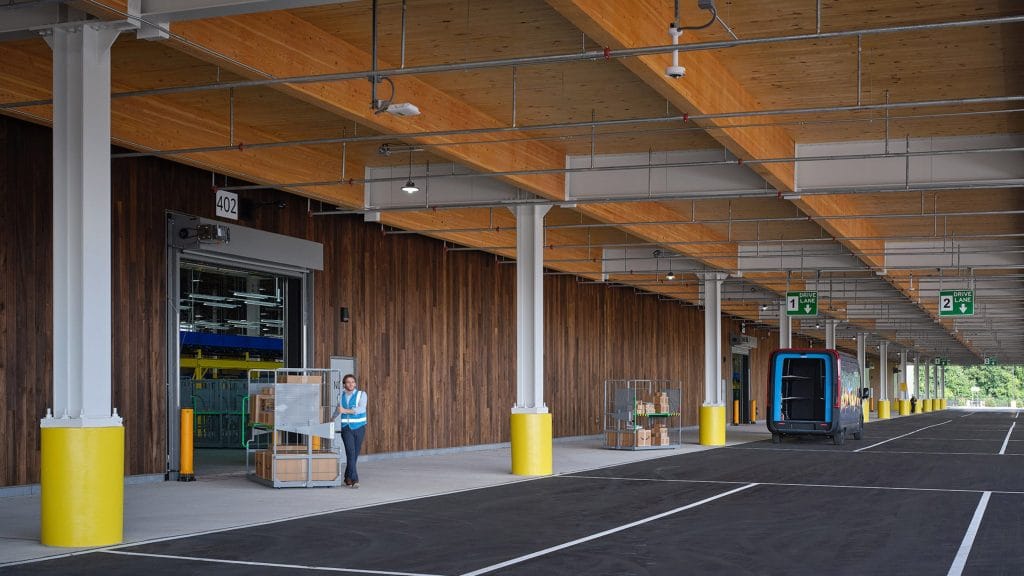Amazon Tests Next-Gen Decarbonization Strategies at New Indiana Facility

• Amazon’s Elkhart, Indiana facility integrates over 40 decarbonization and efficiency systems for real-world testing.
• The site provides data for scaling low-carbon building materials and clean-energy systems across Amazon’s global logistics network.
• Buildings and construction represent roughly 40% of global emissions, placing facility design at the center of Amazon’s 2040 net-zero strategy.
A Living Lab for Carbon Efficiency
In Elkhart, Indiana, Amazon has transformed a delivery station into a testing ground for the next generation of sustainable logistics. Known internally as DII5, the site combines operations with an experimental framework—housing more than 40 market-ready technologies aimed at reducing emissions, energy use, and material intensity.
From the moment you approach the facility, the difference is visible. The building’s exposed timber interiors, vast glass windows, and 170 electric vehicle charging stations set a new tone for how e-commerce infrastructure can function in a low-carbon future.
“DII5 continues years of experimentation across Amazon’s real estate portfolio,” said Daniel Mallory, Amazon’s Vice President of Global Realty. “It brings together lessons learned from how we operate and how we build, and it will guide us as we move closer to our climate goals.”

Building Design as Climate Strategy
Globally, buildings and construction contribute nearly 40% of greenhouse gas emissions, according to the Carbon Leadership Forum. Amazon’s Climate Pledge—committing the company to reach net-zero carbon by 2040—places building innovation among its highest operational priorities.
The Elkhart station serves as a microcosm of that ambition. Its integrated systems measure performance across heating, lighting, materials, and energy use in real time. The company’s intent is not simply to operate one sustainable site, but to determine which design and operational models can be scaled across its logistics and fulfillment network worldwide.
Materials and Systems Under Test
Amazon’s design approach at DII5 moves beyond standard retrofits. Heat pumps replace fossil fuel–based systems, avoiding on-site combustion. Air curtains limit the loss of conditioned air at entryways, improving thermal comfort and reducing electricity demand.
Clerestory windows and large glazed openings allow daylight to replace much of the artificial lighting load. All installed lighting is LED-based, calibrated for efficiency and brightness uniformity across work zones.
Construction materials were chosen for their lower embodied carbon content. Interior walls use wooden studs in place of steel, paired with bio-based wood fiber insulation rather than fiberglass. An ultra-light, low-carbon drywall alternative was used throughout, while acoustic ceilings and flooring rely on renewable finishes.
Even Amazon’s signature “door desks” were reimagined—replaced with salvaged-wood versions supplied by Cambium, a company that upcycles reclaimed timber for commercial interiors.
RELATED ARTICLE: Amazon Unveils Geothermal, Solar-Powered Fulfillment Center in Japan
Capturing Data for Global Application
Each system installed at DII5 is part of a feedback loop. Amazon’s facilities team will monitor emissions, energy, and comfort metrics to determine which technologies offer the best balance between cost and performance. Early findings are expected to influence upcoming builds and retrofits in Amazon’s growing logistics network.
“Buildings are not only operational assets—they’re climate assets,” said a senior facilities engineer involved in the project. “This site helps us quantify that value.”
Some of the early concepts tested at Elkhart are already being integrated into other Amazon facilities, particularly energy-efficient HVAC configurations and daylight-optimised design principles.
Beyond Elkhart: The Global Relevance
Amazon’s experiment arrives amid growing scrutiny of corporate building portfolios. The International Energy Agency has warned that without rapid decarbonization in the construction and real estate sectors, global net-zero targets remain out of reach.
By converting an operational delivery site into a full-scale testing environment, Amazon joins a growing list of multinationals—from Microsoft to IKEA—reassessing their real estate footprints as climate laboratories.
The lessons from DII5 could extend beyond logistics. If proven cost-effective, Amazon’s model of live testing and scalable adoption may serve as a prototype for how large corporates integrate ESG innovation into physical infrastructure.
For Amazon, the stakes extend far beyond one building in Indiana. The Elkhart project is designed to feed evidence-based decisions across thousands of facilities globally. As the company moves toward its 2040 net-zero commitment, what it learns here will help shape not only its own carbon trajectory but the emerging standards for sustainable industrial architecture worldwide.
Follow ESG News on LinkedIn












